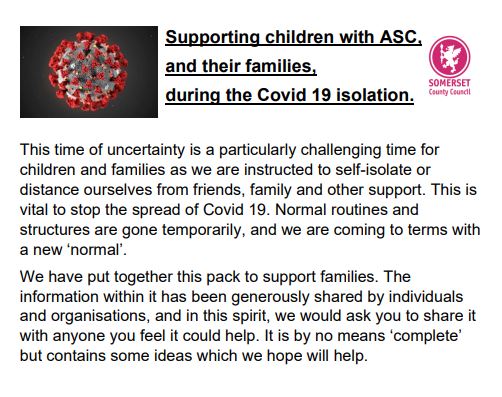Social
Autism Centre Remote Learning
Dear Parents and Carers of Ash and Oak Class
Here is some information that was provided during Lockdowns to support children with autism. As we are still providing remote learning for individuals this year, you might still find the resources and links useful to help support your child with remote learning.
You can also download this PDF:
Information about COVID 19.
Please note - there is a lot of information available about COVID 19, some it is correct and some not. It is best to stick to reliable sources of information
Explaining COVID 19 and the necessary restrictions Social stories allow us to explain complex concepts in a clear, visually supported way:
https://carolgraysocialstories.com/wpcontent/uploads/2020/03/Pandemics-and-theCoronavirus.pdf
https://metro.co.uk/2020/03/29/parents-love-playmobilvideo-explains-coronavirus-kids-12473079/
Social Story for School Closures
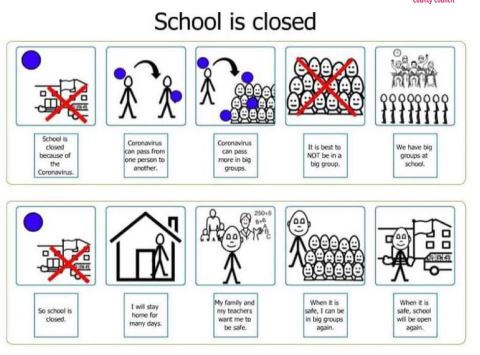
Social Story for Staying at Home
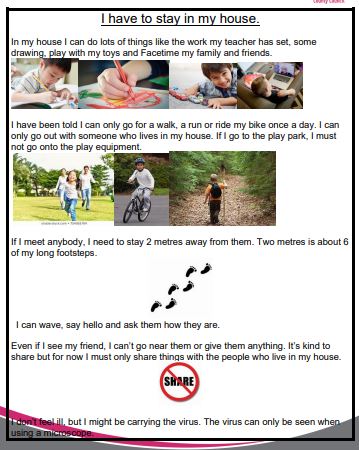
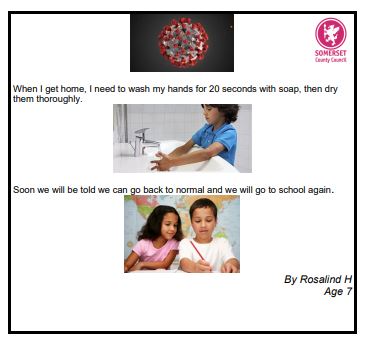
Self-Care Advice
https://www.youtube.com/watch?v=S9VjeIWLnEg
https://www.sensoryintegration.org.uk/News/8821506
Structure and Routine
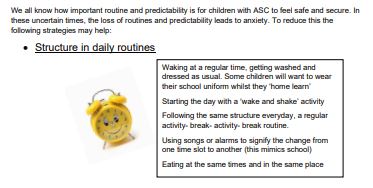
Link for visual time-tables:
https://do2learn.com/picturecards/printcards/
Remember, there is no ‘perfect’ timetable. Create one that supports you as a family. There are many examples to print online but you may prefer objects, photos or drawings. Your child’s school may have shared these resources with you. Their key feature is that they reduce anxiety by providing a predictable structure and visuals reduce the need to take in and remember verbal information.4
Transitioning Between Tasks:
If possible, keep the pre-warning systems you or your child’s school already use and are familiar with.
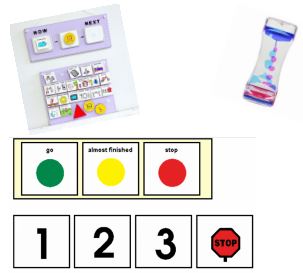
A traffic light system will be useful when you want your child to stop a favoured activity, for instance screen time!
Sleep Routines
Many children with ASC, and their parents, have difficulty with sleep. In times of anxiety this is likely to be more difficult, and this is understandable. If possible, keep to the usual routine as it provides security. This advice focuses on; establishing a routine, a comfortable bedroom, explaining why we sleep using a social story, the effects of diet and medication.
https://www.autism.org.uk/about/health/sleep.aspx
More advice...
https://cerebra.org.uk/get-advice-support/sleep
Emotional Regulation and Managing Behaviour
It is natural that everyone will be more emotionally heightened during this situation. Being kind to yourself, not expecting perfection and accepting what you cannot control will help.
Primary prevention – Emptying the stress bucket.
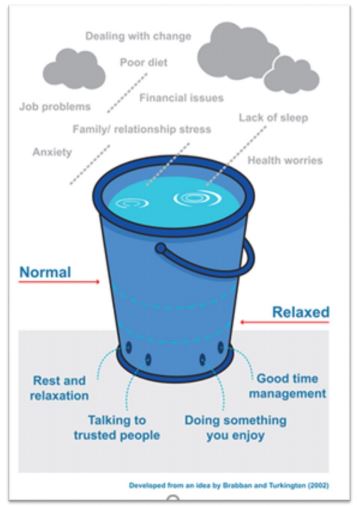
This bucket fills up with all the stresses of the day, and can be emptied by a good night's sleep, or by engaging with things which make us feel happy and relaxed. If the bucket starts to fill or overflow, we can start to feel anxious and overwhelmed.
• A regular routine of activities that reduce stress will support emotional regulation.
• You may be prevented from accessing your child’s preferred activities, swimming, going to the park. Look at the input they receive from the activity, swimming gives strong resistance, and try to replicate this, resistance using therapy bands or brushing the floor
Your child may already use a system in school to show their regulation;
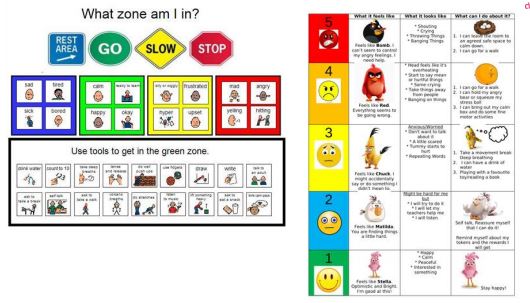
But everyone sometimes gets ‘overwhelmed’…….
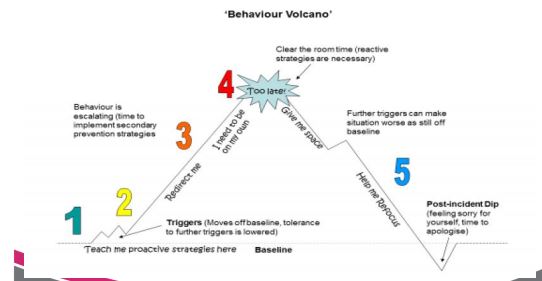
But what happens if your child moves up the volcano and is heading for a meltdown……
1 If possible, redirect them to a quiet and calming part of the house
2 If not possible to redirect your child, try and redirect siblings and family pets to another room.
3. Avoid interacting with your child
- Try not to talk to your child when they are having a meltdown. (verbal information is difficult to process when you are distressed) .
- Try not to make eye contact with them .
- If possible, move away from them (keeping an eye on them from a distance).
4. Keeping the area safe • Move anything breakable away from your child - If your child is head butting the wall, you can place a cushion against the wall.
5. After the Meltdown
- When your child calms, tell them (using visual cues ideally) what you are doing next and engage them in an activity to move them on.
- Your child may have another meltdown and you will have to do all this again. But it is important to stick to your rules. If your child gets what they want when they have a meltdown, they will have a meltdown every time they want something. It is important to teach your child that having a meltdown will not get them what they want.
More advice can be found at;
https://www.autism.org.uk/about/behaviour/challenging-behaviour.aspx
https://www.challengingbehaviour.org.uk/understanding-behaviour/understanding-behaviour.html
https://cerebra.org.uk/download/factsheet-managing-challenging-behaviour
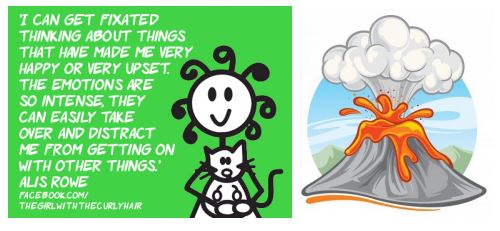
Strategies for Self-Regulation
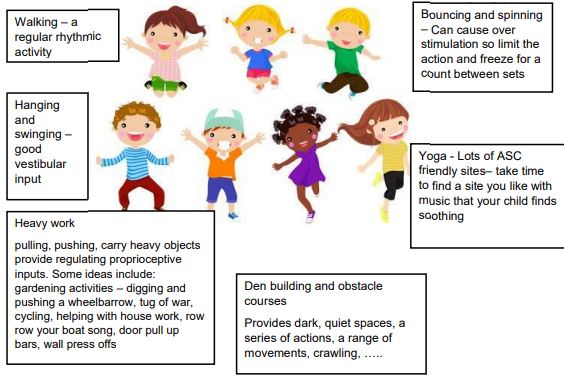
Some websites for further information around proprioceptive regulatory strategies and activities include:
https://lemonlimeadventures.com/100-sensory-activities/
https://www.andnextcomesl.com/2015/06/heavy-work-activities-for-kids.html
Looking After Yourselves
Last but definitely not least….. Caring for others is demanding, to keep going for a prolonged time you will need to look after yourself.
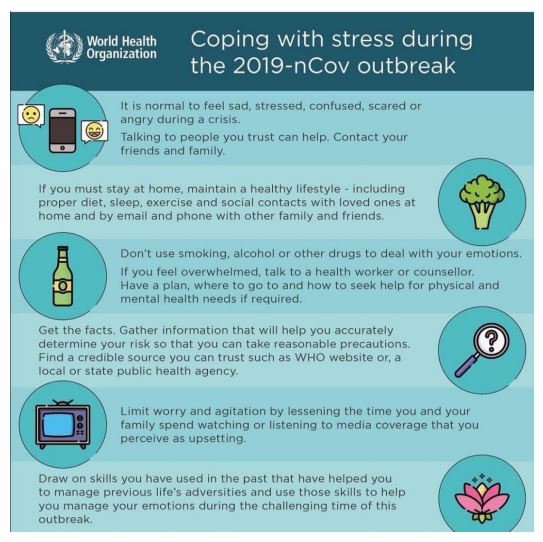
Reach out to others…
https://somersetparentcarerforum.org.uk/
http://www.supportservicesforeducation.co.uk/Services/3326

